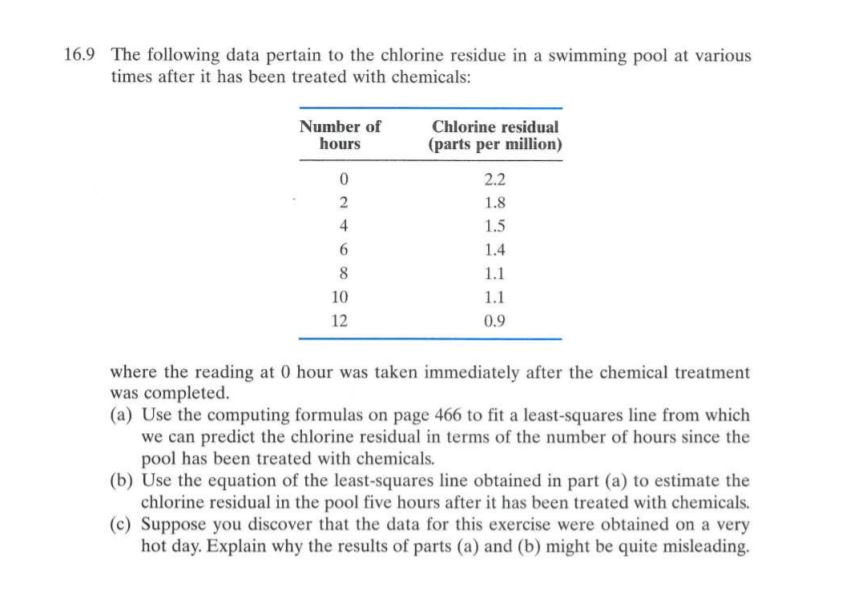16.9 The following data pertain to the chlorine residue in a swimming pool at various times after it has been treated with chemicals: Number of hours Chlorine residual (parts per million) 2.2 2 1.8 4 1.5 6. 1.4 8. 1.1 10 1.1 12 0.9 where the reading at 0 hour was taken immediately after the chemical treatment was completed. (a) Use the computing formulas on page 466 to fit a least-squares line from which we can predict the chlorine residual in terms of the number of hours since the pool has been treated with chemicals. (b) Use the equation of the least-squares line obtained in part (a) to estimate the chlorine residual in the pool five hours after it has been treated with chemicals. (c) Suppose you discover that the data for this exercise were obtained on a very hot day. Explain why the results of parts (a) and (b) might be quite misleading.
16.9 The following data pertain to the chlorine residue in a swimming pool at various times after it has been treated with chemicals: Number of hours Chlorine residual (parts per million) 2.2 2 1.8 4 1.5 6. 1.4 8. 1.1 10 1.1 12 0.9 where the reading at 0 hour was taken immediately after the chemical treatment was completed. (a) Use the computing formulas on page 466 to fit a least-squares line from which we can predict the chlorine residual in terms of the number of hours since the pool has been treated with chemicals. (b) Use the equation of the least-squares line obtained in part (a) to estimate the chlorine residual in the pool five hours after it has been treated with chemicals. (c) Suppose you discover that the data for this exercise were obtained on a very hot day. Explain why the results of parts (a) and (b) might be quite misleading.
Linear Algebra: A Modern Introduction
4th Edition
ISBN:9781285463247
Author:David Poole
Publisher:David Poole
Chapter7: Distance And Approximation
Section7.3: Least Squares Approximation
Problem 34EQ
Related questions
Concept explainers
Equations and Inequations
Equations and inequalities describe the relationship between two mathematical expressions.
Linear Functions
A linear function can just be a constant, or it can be the constant multiplied with the variable like x or y. If the variables are of the form, x2, x1/2 or y2 it is not linear. The exponent over the variables should always be 1.
Question
100%
<>

Transcribed Image Text:16.9 The following data pertain to the chlorine residue in a swimming pool at various
times after it has been treated with chemicals:
Number of
hours
Chlorine residual
(parts per million)
2.2
1.8
4
1.5
1.4
8
1.1
10
1.1
12
0.9
where the reading at 0 hour was taken immediately after the chemical treatment
was completed.
(a) Use the computing formulas on page 466 to fit a least-squares line from which
we can predict the chlorine residual in terms of the number of hours since the
pool has been treated with chemicals.
(b) Use the equation of the least-squares line obtained in part (a) to estimate the
chlorine residual in the pool five hours after it has been treated with chemicals.
(c) Suppose you discover that the data for this exercise were obtained on a very
hot day. Explain why the results of parts (a) and (b) might be quite misleading.
Expert Solution
This question has been solved!
Explore an expertly crafted, step-by-step solution for a thorough understanding of key concepts.
This is a popular solution!
Trending now
This is a popular solution!
Step by step
Solved in 2 steps with 2 images

Knowledge Booster
Learn more about
Need a deep-dive on the concept behind this application? Look no further. Learn more about this topic, statistics and related others by exploring similar questions and additional content below.Recommended textbooks for you

Linear Algebra: A Modern Introduction
Algebra
ISBN:
9781285463247
Author:
David Poole
Publisher:
Cengage Learning

Glencoe Algebra 1, Student Edition, 9780079039897…
Algebra
ISBN:
9780079039897
Author:
Carter
Publisher:
McGraw Hill

Linear Algebra: A Modern Introduction
Algebra
ISBN:
9781285463247
Author:
David Poole
Publisher:
Cengage Learning

Glencoe Algebra 1, Student Edition, 9780079039897…
Algebra
ISBN:
9780079039897
Author:
Carter
Publisher:
McGraw Hill